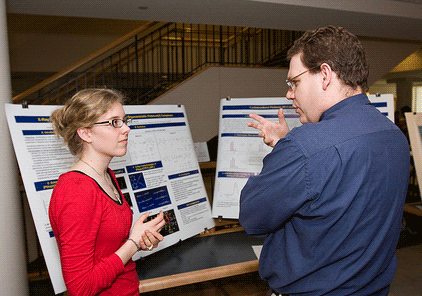Poster Title
Faculty Advisor
Erick Agrimson, Sue Hummel, Tammi Wiesner
Department
Sonography
Abstract
Stephanie Beach & Jordan Olson
Volume Imaging
Ultrasound has many advantages for diagnostic imaging including excellent spatial and contrast resolution, a relatively low cost, and lack of ionizing radiation. However there are additional aspects that are being introduced with “volumetric image acquisition” such as real-time and multiplanar capabilities allowing imaging in the ideal plane for the best interpretation of pathology within a region of interest (Wilson 2009). This technology is capable of producing 3D images allowing for volume acquisition, with subsequent on-line or off-line multiplanar reconstruction (MPR), multislice imaging and volumetric analysis (Elliott 2007). Multiplanar reconstruction and multislice are commonly used in CT and MRI, however, these new and imaginative techniques could also offer considerable diagnostic potential for non-obsteteric ultrasound (Elliott 2007). The use of volume data for measurement is likely to speed and improve our assessment of complex anatomical and pathological structures (Elliott 2007).
Volume Imaging provides significant advantages in regards to imaginative workflow processes as well as a faster and more efficient method of examination and security of imaging data (Phillips). All measurements can be made from stored data while a patient is returning to the surgeon and the next patient is already being scanned leading to significant benefits for workflow efficiency. (Phillips). Volume imaging has helped clinicians make decisions regarding management and types of surgical approaches because of how impressive the images and virtual tours were (Phillips). Volume ultrasound is likely to remove the uncertainty of possibly missing pathology during an exam (Elliott 2007). Volume ultrasound has the potential to be the next significant step. Further evaluation of this promising technique is required, but already there are proven benefits for diagnostic confidence, accuracy and changes is clinical practice (Elliott 2007).
References
Elliott, S.T. 2007. Volume Ultrasound: the next big thing? British Journal of Radiology, 81, 8-9. Doi: 10.1259/bjr/13475432
Phillips. 2011. Volume Imaging for your ultrasound department. Retrieved from www.phillips.com/iU22
Wilson, S. 2009. Volume Imaging in the Abdomen with Ultrasound: How we do it. American Journal of Roentgenology, 193, 79-85. Doi: 10.2214/AJR.08.2273
Start Date
19-4-2012 11:00 AM
End Date
19-4-2012 1:00 PM
Volume Imaging
Stephanie Beach & Jordan Olson
Volume Imaging
Ultrasound has many advantages for diagnostic imaging including excellent spatial and contrast resolution, a relatively low cost, and lack of ionizing radiation. However there are additional aspects that are being introduced with “volumetric image acquisition” such as real-time and multiplanar capabilities allowing imaging in the ideal plane for the best interpretation of pathology within a region of interest (Wilson 2009). This technology is capable of producing 3D images allowing for volume acquisition, with subsequent on-line or off-line multiplanar reconstruction (MPR), multislice imaging and volumetric analysis (Elliott 2007). Multiplanar reconstruction and multislice are commonly used in CT and MRI, however, these new and imaginative techniques could also offer considerable diagnostic potential for non-obsteteric ultrasound (Elliott 2007). The use of volume data for measurement is likely to speed and improve our assessment of complex anatomical and pathological structures (Elliott 2007).
Volume Imaging provides significant advantages in regards to imaginative workflow processes as well as a faster and more efficient method of examination and security of imaging data (Phillips). All measurements can be made from stored data while a patient is returning to the surgeon and the next patient is already being scanned leading to significant benefits for workflow efficiency. (Phillips). Volume imaging has helped clinicians make decisions regarding management and types of surgical approaches because of how impressive the images and virtual tours were (Phillips). Volume ultrasound is likely to remove the uncertainty of possibly missing pathology during an exam (Elliott 2007). Volume ultrasound has the potential to be the next significant step. Further evaluation of this promising technique is required, but already there are proven benefits for diagnostic confidence, accuracy and changes is clinical practice (Elliott 2007).
References
Elliott, S.T. 2007. Volume Ultrasound: the next big thing? British Journal of Radiology, 81, 8-9. Doi: 10.1259/bjr/13475432
Phillips. 2011. Volume Imaging for your ultrasound department. Retrieved from www.phillips.com/iU22
Wilson, S. 2009. Volume Imaging in the Abdomen with Ultrasound: How we do it. American Journal of Roentgenology, 193, 79-85. Doi: 10.2214/AJR.08.2273

